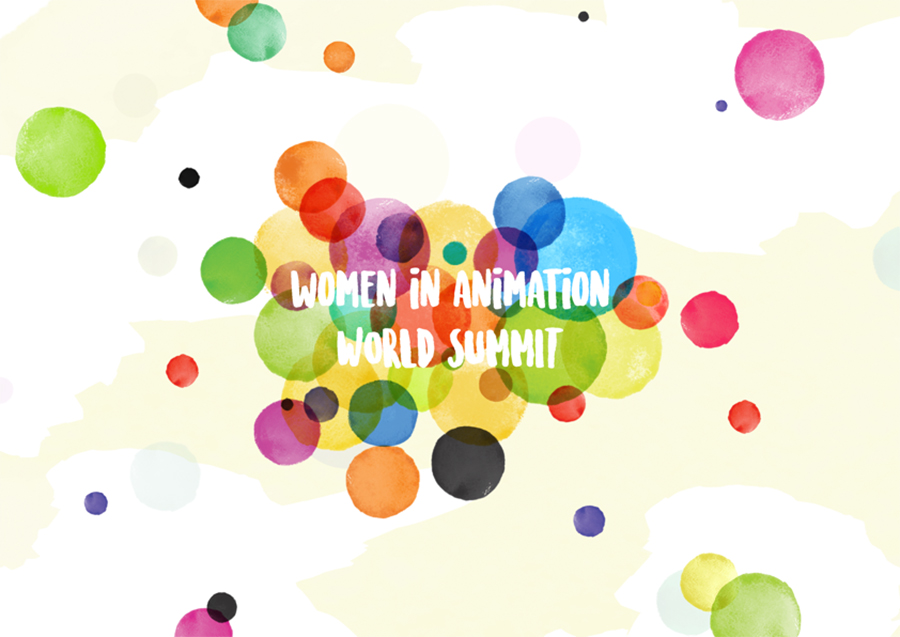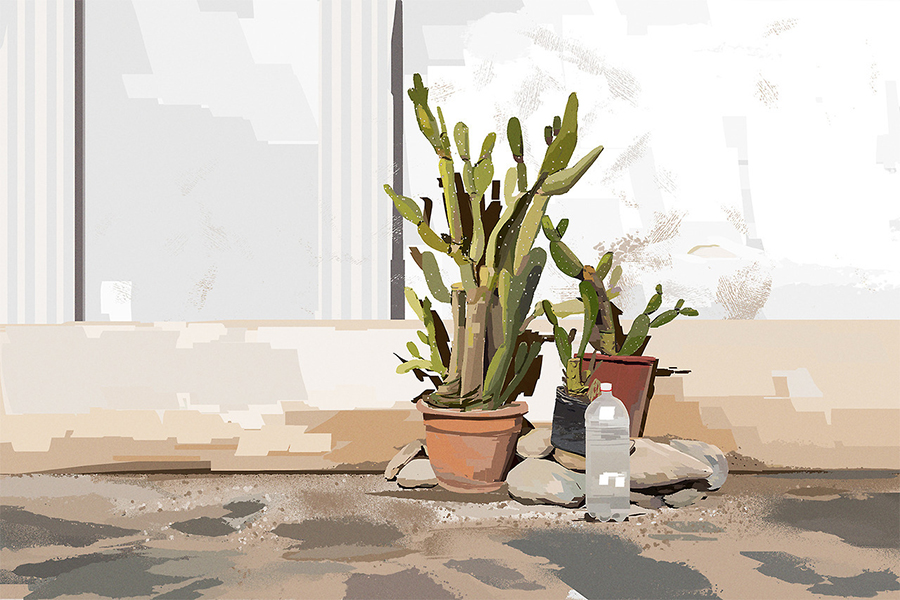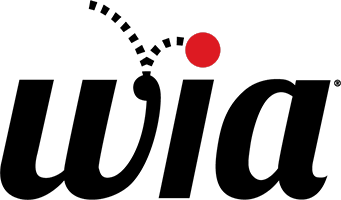SPOTLIGHT STORIES: CELINE DESRUMAUX
Interview conducted by Tracey Miller-Zarneke
The 2019 WIA World Summit is honored to display the beautiful art of Celine Desrumaux as the visualization of its programming based on the theme of “Belonging.” An award-winning production designer, Celine captured “the intersection and universality of women working in the field today,” according to WIA Vice President Jinko Gotoh. “Working in watercolor, I can let the colors flow together a bit, while still allowing them to retain their powerful individual presence. In my artistic perspective, it’s a representation of the diversity of women in our community, and how we inspire one another,” explains Celine.
Born 34 years ago in a small town in France, Celine followed her passion for art through graduation from Supinfocom in 2008, after which she moved to London to work at a number of studios including Framestore, Cartoon Network, Aardman, Nexus and finally as a commercial director at Passion Pictures. In 2011, after two years of work in her spare time, Celine released the short film “Countdown” which earned several awards. She then went on to serve a co-production designer on The Little Prince, has won an Annie for her work on Google Spotlight Stories’ Age of Sail and is currently production designing for Netflix/Pearl’s upcoming Over the Moon.
After generously designing the logo for the WIA World Summit, Celine took a few moments to share some of her thoughts and experience with our membership as well.
Did your parents/family encourage you in your pursuit of art as a career? If so, how? If not, how did you move forward in your pursuit?
My parents didn’t have the chance to go to high school–life was different at that time–but they always supported me in everything I wanted to do, even if it was the “unknown” for them. My mom was a huge fan of movies, both French and American, and I discovered cinema with her when I was a child. I was good at school but I wanted to work in cinema, and my parents supported me even when my teachers didn’t: my teachers wanted me to go into science and not art, but my love of cinema prevailed!
What, if any, adversities have you faced in your career or life in general, and how did they shape the leader you are today?
When I graduated in 2008, it was in the midst of a global economic crisis. I moved to London, where finding a job was not easy. I got lucky, and a director who was developing his show at Cartoon Network gave me the opportunity to voice my art into their development. I was hired to do some CG, and I ended up doing some color keys. My first four years working in animation were a heap of different experiences: as an editor on 2D short, a compositor on a stop-motion project at Aardman, as a 3D lighting and, textures artist on the 2D Harry Potter sequence at Framestore, and as a Commercial Director and Art Director at Passion Pictures.
While I was learning from various colleagues and jobs, I was also putting together my own short movie, entirely alone. At first I tried to look for funding, but I was often told, “We don’t give money to short movies. If you are passionate, you will do it on your own time.” So I did. It took me two years to achieve it.
When all was said and done, a studio did offer me money for my short. The terms were that I’d get £10K, they would get credited as the Producer, and as my favor to them, I would change the music in my movie to something that’d be a “sexier” fit. I had to refuse. I decided that maintaining artistic integrity was more important to me. And while it was a difficult decision to make, in the end I was rewarded. The short was a success, and it landed me a role on The Little Prince, my first job as an artist in feature animation. The Little Prince opened many doors for me, and I went on to have amazing experiences working with different studios and different projects.
As I have moved through my career, I have often felt that not being linked to a studio or an artistic specialty was a weakness. But recently, I have grown to appreciate that the diversity of my experience has opened many doors. I think now I have the opportunity to work with people who know I will bring something different, and that I will surprise them.
Has any project ever posed a challenge to you because you were female? If so, how? If not, what was one of your greatest challenges in making that happen?
Like many women, I have encountered challenges in the workplace. Often, it has been difficult for me to know whether the difficulty arises because I am a woman, or because I am young, or both.
I also find that culture and networking can be difficult, especially if you try to move from one community circle to another one: sometimes those circles are so strong that it can feel discouraging if you’re from another country. And coming from a renowned school is great but it’s a double-edged sword, it can also seclude you from the diversity outside of this realm of networking. It’s not a “boys’ club,” but it’s still a club.
I believe strongly in artistic and personal integrity, and I advocate for the proper treatment of my fellow artists and staff. In the past, that has caused friction. But I strongly believe in shaping the environment you would like to work in, and will continue to forge my career in my own way.
Why is an organization like Women in Animation important?
An organization like Women In Animation is important because first and foremost, it acknowledges that equality issues exist in our industry.
To anyone who may claim we have made enough progress, Women in Animation provides articles or testimonies to challenge that line of thinking. The numbers don’t lie. Women are still dramatically underrepresented in creative roles, and even when they’re afforded them, having the confidence and support to successfully rise to leadership positions can be very difficult. WIA supports and empowers women to express themselves creatively, and so I hope that women will keep working to rise up in the ranks, knowing they have the power of a community to support them.
What advantages are there to having a diverse workforce when producing animation?
A diverse workforce brings huge advantages to a show. Creatively, it brings more perspectives and ideas. These ideas can lend themselves to authenticity, inventiveness, and sincerity. The stories and visual languages of animation are consistently bolstered by fresh voices and new styles. We can only really expect our art form to evolve and grow by bringing in and empowering creative voices we have not have had the opportunity to hear in the past.
I am the Production Designer on Over the Moon, directed by Glen Keane, and I am pleased to say that my pre-production team is made of five men and six women (including myself) with six nationalities represented. I’m proud to reach the 50/50 mark, and to enjoy our diversity!
What advice do you have for young people looking at animation or other artistic industries as their career field?
Stay true to yourself.
Don’t try to look like what you think a studio is looking for.
Be confident in yourself, and in what you can bring to a project.
And have faith that while the path may not be what you had expected, it can bring you to a place where you are creatively fulfilled.
How do you keep your artistic spirit refreshed, even when under the pressure of production deadlines or life challenges?
Travel, photography, and literature are huge sources of my inspiration. I always have a camera on me so I can capture lights, shapes, compositions, and ideas from everyday life.
I make sure to build in time to recharge after each of my major projects. I often travel for 2-3 months between shows. For me, creative energy is inspired by seeing new things and places, more than relaxing on a beach ever would.
Obviously, when I’m in the middle of a project, I can’t take extended breaks. But I will prioritize allowing myself to step outside and take a walk to clear my head.
I also love to read. I can look at the cover of a book I’ve read, and fill my mind with images, feelings, and landscapes.
Last, finding fellow creative players has been critical for me: it means I can discuss creative challenges, and bounce ideas back and forth to find a solution. As a Production Designer, having the Director as your creative partner is the best relationship you can hope to have on a project, but beyond that, this relationship supports the story and the movie itself even more strongly. The best movies are the ones that design and story make together.
Any other thoughts or advice you wish to share with our membership?
Communication is the key to everything.
I remember on one project, in my daily check in with artists, I asked, “How is it going, is there anything you want to talk about?” And one artist answered, “I’m struggling with this character. I don’t get it.” I was really happy she told me how she felt. It made me take the time to think with her, “why this character was so difficult to do?” I didn’t have all the answers, but raising the issue and talking it through definitely helped her, and it helped me. She was part of my team, and my job was to make my team succeed. It’s important for me to know that my team is speaking up and telling me what’s working and what’s not working. If you know the issue exists, you can try to find a solution or a compromise, but if no one talks, then you have a real challenge on your hands.
WIA is grateful for the time Celine spent on the logo and talking with our membership, and wishes her all the best in her bright and colorful future!



